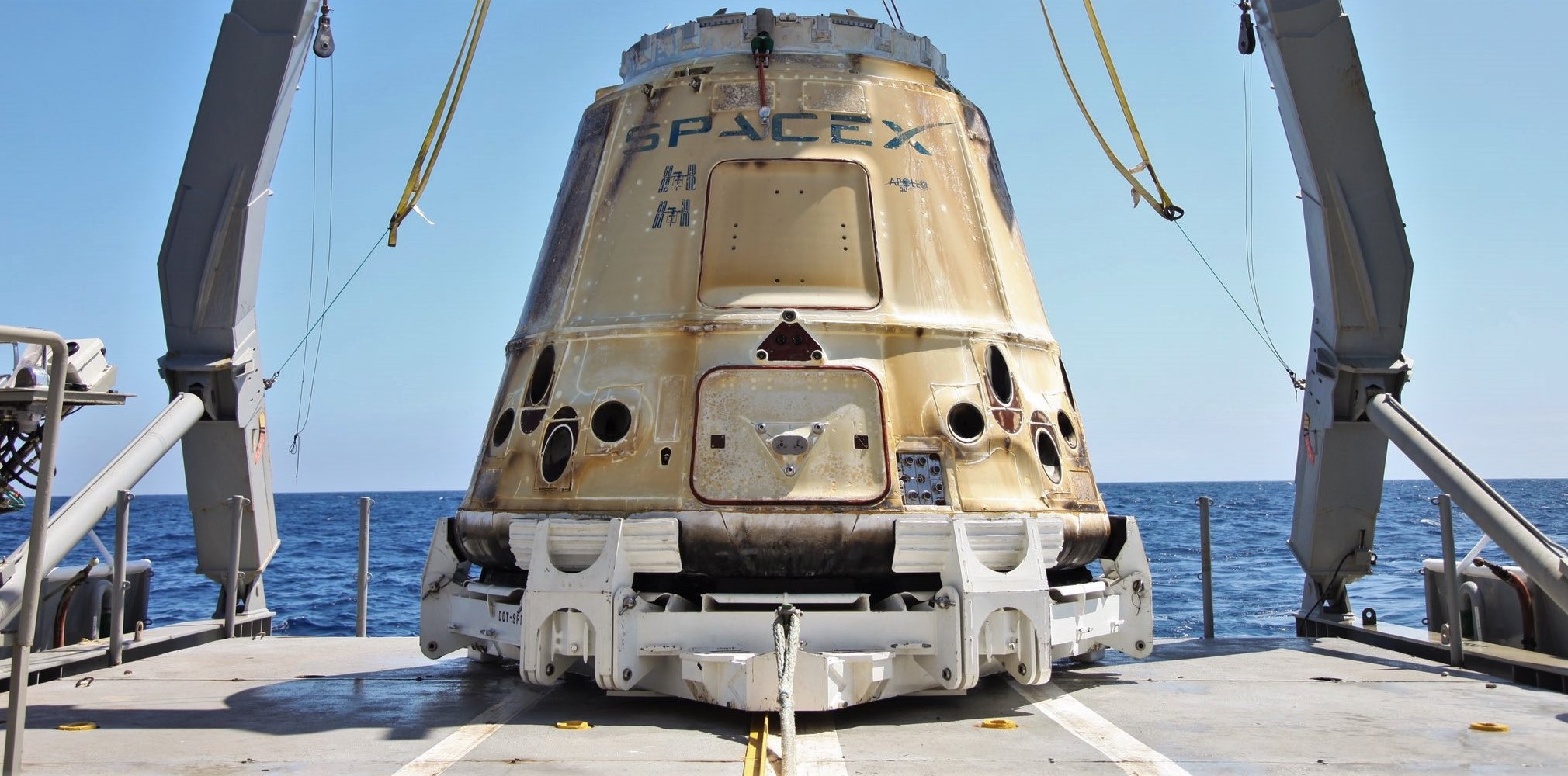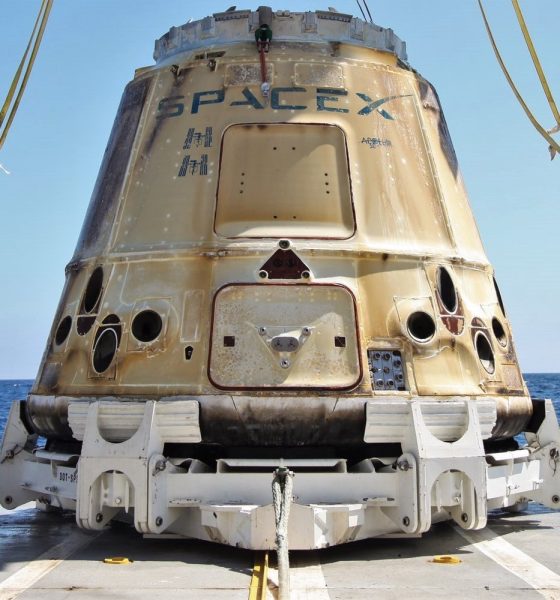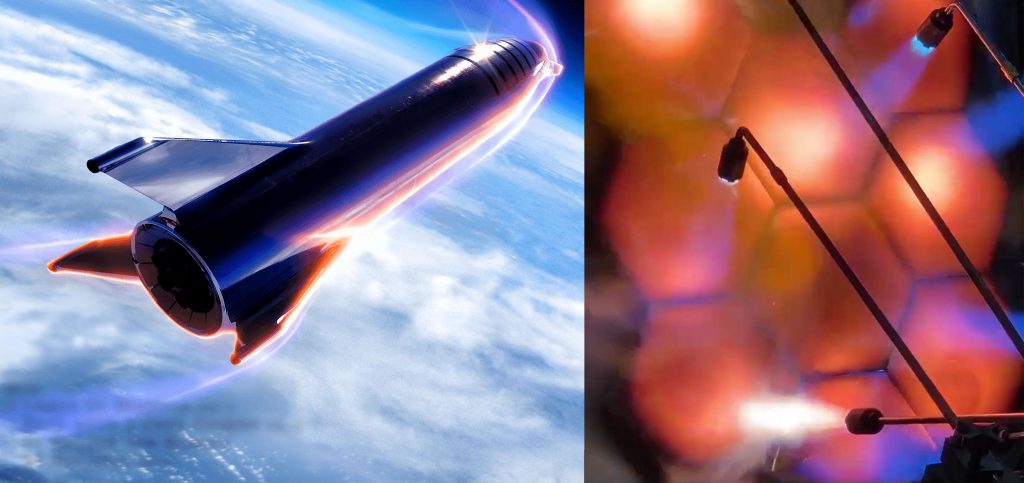

News
SpaceX’s first thrice-flown Cargo Dragon returns from orbit with Starship tiles intact
After a flawless reentry and splashdown on August 27th, SpaceX’s first thrice-flown Cargo Dragon spacecraft completed its latest mission, arriving in Port of Los Angeles aboard SpaceX vessel NRC Quest.
The successful completion of NASA Commercial Resupply Mission 18 (CRS-18) means that SpaceX is officially the first and only company to launch the same orbital spacecraft three times. Meanwhile, Cargo Dragon capsule C108 also happened to mark the first known orbital flight test of hardware that may be destined for use on SpaceX’s next-generation Starship launch vehicle, taking the shape of four ceramic tiles installed as part of its ablative PICA-X heat shield.
Cargo Dragon’s CRS-18 mission successfully lifted off on its way to the International Space Station (ISS) on July 25th and was berthed to the ISS roughly two days later, completed its delivery of several tons worth of cargo. During the launch webcast, one of the SpaceX hosts noted that black tiles visible on Cargo Dragon’s heat shield – distinct beside its silvery water-sealed PICA-X tiles – were prototypes of a ceramic heat shield material being analyzed for possible use on Starship.
CEO Elon Musk confirmed this after the first launch attempt was scrubbed by weather, stating that SpaceX was looking into the use of “thin [ceramic] tiles” to protect Starship’s windward (atmosphere-facing) half during orbital reentries. Prior to this development, Musk had proposed and posted videos of real-world tests of a steel Starship heat shield concept, in which extra energy could be wicked away by ‘transpiring’ liquid oxygen or methane through microscopic holes on each tile’s leading edge.
Although particular species of stainless steel do feature exceptionally high melting points and structural characteristics at ultra-high temperatures (> 1400C/2500F), some unofficial analyses of the numbers involved indicated that the density and weight of steel could rapidly hinder any benefits derived from its use as a heat shield. Musk appeared to confirm this in his July 24th comments, indicating that thin ceramic tiles on the windward side and nothing on the leeward side of Starship looked like the “lightest option”.

Indeed, ceramics were so prevalent on the Space Shuttle – the only semi-routinely reusable space plane ever developed – in large part because they can be made spectacularly light. The Shuttle’s main ceramic tiles had a density of 155 kg/m³ (9 lb/ft³), about five times denser than styrofoam or roughly the same density as freshly-fallen snow and balsa wood. Stainless steel is about 50 times denser, on average. To use Musk’s own 2017 turn-of-phrase, adding thick steel tiles to Starship’s already-steel skin was probably a bit too much like “building a box in a box”, whereas prioritizing ceramic tiles presumably cuts the shield’s mass by a factor of something like 20-100+.
Although the Shuttle did make extensive use of ceramic shielding, that shielding – specifically, reinforced carbon-carbon (RCC) tiles about as fragile as the material people are familiar with – and a mixture of organizational ineptitude infamously lead to the death 7 NASA astronauts and was generally a nightmare to deal with. SpaceX certainly won’t have to deal with the foam and solid rocket boosters that a lot of Shuttle’s ceramic problems can be traced to, but the company will likely be laser-focused on producing a form of ceramic shielding that isn’t nearly as fragile as Shuttle-derived materials.
The fact that Cargo Dragon’s ceramic Starship tile prototypes appear to be almost completely unscathed after their first orbital reentry is an excellent sign that SpaceX is making progress in the materials design and certification department, or is at least taking flight-testing extremely seriously.
SpaceX CEO Elon Musk is expected to provide an official update on Starship no earlier than late September, a presentation that will likely include details about the route the company is taking with the massive spaceship’s heat shielding.
Check out Teslarati’s Marketplace! We offer Tesla accessories, including for the Tesla Cybertruck and Tesla Model 3.

Elon Musk
Elon Musk’s X will start using a Tesla-like software update strategy
The initiative seems designed to accelerate updates to the social media platform, while maintaining maximum transparency.

Elon Musk’s social media platform X will adopt a Tesla-esque approach to software updates for its algorithm.
The initiative seems designed to accelerate updates to the social media platform, while maintaining maximum transparency.
X’s updates to its updates
As per Musk in a post on X, the social media company will be making a new algorithm to determine what organic and advertising posts are recommended to users. These updates would then be repeated every four weeks.
“We will make the new 𝕏 algorithm, including all code used to determine what organic and advertising posts are recommended to users, open source in 7 days. This will be repeated every 4 weeks, with comprehensive developer notes, to help you understand what changed,” Musk wrote in his post.
The initiative somewhat mirrors Tesla’s over-the-air update model, where vehicle software is regularly refined and pushed to users with detailed release notes. This should allow users to better understand the details of X’s every update and foster a healthy feedback loop for the social media platform.
xAI and X
X, formerly Twitter, has been acquired by Elon Musk’s artificial intelligence startup, xAI last year. Since then, xAI has seen a rapid rise in valuation. Following the company’s the company’s upsized $20 billion Series E funding round, estimates now suggest that xAI is worth tens about $230 to $235 billion. That’s several times larger than Tesla when Elon Musk received his controversial 2018 CEO Performance Award.
As per xAI, the Series E funding round attracted a diverse group of investors, including Valor Equity Partners, Stepstone Group, Fidelity Management & Research Company, Qatar Investment Authority, MGX, and Baron Capital Group, among others. Strategic partners NVIDIA and Cisco Investments also continued support for building the world’s largest GPU clusters.
News
Tesla FSD Supervised wins MotorTrend’s Best Driver Assistance Award
The decision marks a notable reversal for the publication from prior years, with judges citing major real-world improvements that pushed Tesla’s latest FSD software ahead of every competing ADAS system.

Tesla’s Full Self-Driving (Supervised) system has been named the best driver-assistance technology on the market, earning top honors at the 2026 MotorTrend Best Tech Awards.
The decision marks a notable reversal for the publication from prior years, with judges citing major real-world improvements that pushed Tesla’s latest FSD software ahead of every competing ADAS system. And it wasn’t even close.
MotorTrend reverses course
MotorTrend awarded Tesla FSD (Supervised) its 2026 Best Tech Driver Assistance title after extensive testing of the latest v14 software. The publication acknowledged that it had previously criticized earlier versions of FSD for erratic behavior and near-miss incidents, ultimately favoring rivals such as GM’s Super Cruise in earlier evaluations.
According to MotorTrend, the newest iteration of FSD resolved many of those shortcomings. Testers said v14 showed far smoother behavior in complex urban scenarios, including unprotected left turns, traffic circles, emergency vehicles, and dense city streets. While the system still requires constant driver supervision, judges concluded that no other advanced driver-assistance system currently matches its breadth of capability.
Unlike rival systems that rely on combinations of cameras, radar, lidar, and mapped highways, Tesla’s FSD operates using a camera-only approach and is capable of driving on city streets, rural roads, and freeways. MotorTrend stated that pure utility, the ability to handle nearly all road types, ultimately separated FSD from competitors like Ford BlueCruise, GM Super Cruise, and BMW’s Highway Assistant.
High cost and high capability
MotorTrend also addressed FSD’s pricing, which remains significantly higher than rival systems. Tesla currently charges $8,000 for a one-time purchase or $99 per month for a subscription, compared with far lower upfront and subscription costs from other automakers. The publication noted that the premium is justified given FSD’s unmatched scope and continuous software evolution.
Safety remained a central focus of the evaluation. While testers reported collision-free operation over thousands of miles, they noted ongoing concerns around FSD’s configurable driving modes, including options that allow aggressive driving and speeds beyond posted limits. MotorTrend emphasized that, like all Level 2 systems, FSD still depends on a fully attentive human driver at all times.
Despite those caveats, the publication concluded that Tesla’s rapid software progress fundamentally reshaped the competitive landscape. For drivers seeking the most capable hands-on driver-assistance system available today, MotorTrend concluded Tesla FSD (Supervised) now stands alone at the top.
News
Elon Musk’s Grokipedia surges to 5.6M articles, almost 79% of English Wikipedia
The explosive growth marks a major milestone for the AI-powered online encyclopedia, which was launched by Elon Musk’s xAI just months ago.

Elon Musk’s Grokipedia has grown to an impressive 5,615,201 articles as of today, closing in on 79% of the English Wikipedia’s current total of 7,119,376 articles.
The explosive growth marks a major milestone for the AI-powered online encyclopedia, which was launched by Elon Musk’s xAI just months ago. Needless to say, it would only be a matter of time before Grokipedia exceeds English Wikipedia in sheer volume.
Grokipedia’s rapid growth
xAI’s vision for Grokipedia emphasizes neutrality, while Grok’s reasoning capabilities allow for fast drafting and fact-checking. When Elon Musk announced the initiative in late September 2025, he noted that Grokipedia would be an improvement to Wikipedia because it would be designed to avoid bias.
At the time, Musk noted that Grokipedia “is a necessary step towards the xAI goal of understanding the Universe.”
Grokipedia was launched in late October, and while xAI was careful to list it only as Version 0.1 at the time, the online encyclopedia immediately earned praise. Wikipedia co-founder Larry Sanger highlighted the project’s innovative approach, noting how it leverages AI to fill knowledge gaps and enable rapid updates. Netizens also observed how Grokipedia tends to present articles in a more objective manner compared to Wikipedia, which is edited by humans.
Elon Musk’s ambitious plans
With 5,615,201 total articles, Grokipedia has now grown to almost 79% of English Wikipedia’s article base. This is incredibly quick, though Grokipedia remains text-only for now. xAI, for its part, has now updated the online encyclopedia’s iteration to v0.2.
Elon Musk has shared bold ideas for Grokipedia, including sending a record of the entire knowledge base to space as part of xAI’s mission to preserve and expand human understanding. At some point, Musk stated that Grokipedia will be renamed to Encyclopedia Galactica, and it will be sent to the cosmos.
“When Grokipedia is good enough (long way to go), we will change the name to Encyclopedia Galactica. It will be an open source distillation of all knowledge, including audio, images and video. Join xAI to help build the sci-fi version of the Library of Alexandria!” Musk wrote, adding in a later post that “Copies will be etched in stone and sent to the Moon, Mars and beyond. This time, it will not be lost.”








